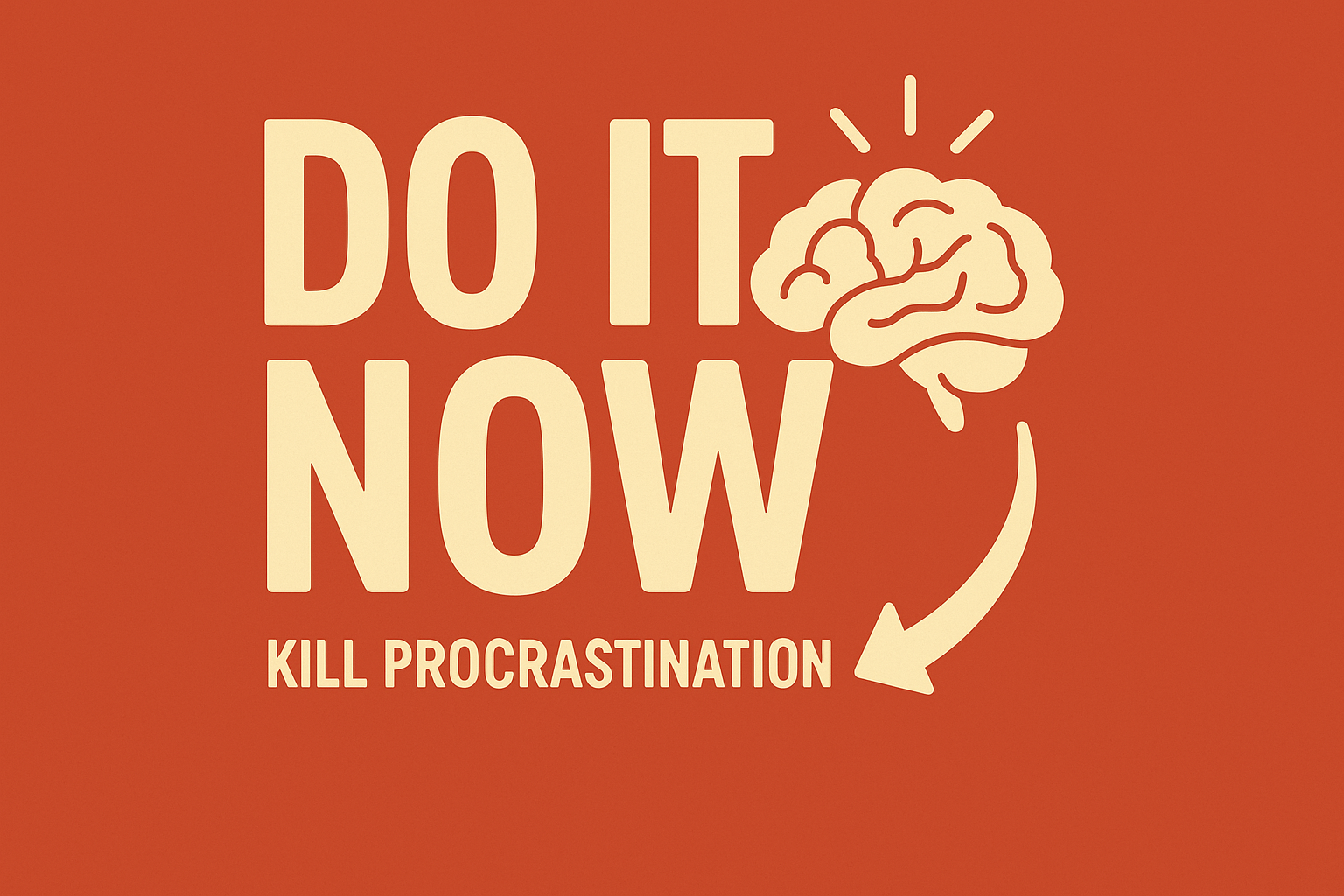Table of Contents
ToggleOvercoming procrastination is a common foe, but the antidote is a constant mental shift toward urgency. Every day when you get up, say over and over to yourself:
Do it now. Do it now. Do it now
This is encapsulated in the journal notes’ motto, “Do it now.”This is a simple command; you can achieve everything by repeating it until you achieve your goals. According to psychology and neuroscience, this type of repetition can rewire our habits. Research shows you can change your daily routine and habits through repetition. Simply put, by consistently repeating “Do it now” daily, you are informing your brain that taking immediate action is now the norm.
Repetition: Training Your Subconscious
Repetition is not a pep talk; it forges the neural circuits that propel habit. As one review of neuroscience explains, once you’ve learned a behavior, exposure to the cue will automatically stimulate that response—habits “do not need much cognitive input” because they’ve been prewired by repetition. By saying to yourself, “Do it now” each morning (or whenever you get delay creeping in), you start to rewire your automatic answers. Pairing that sentence with beginning an assignment creates a new habit loop. Your brain learns over time that delay means a cue to “Do it now,” disrupting the typical procrastination pause.
Repeating a short, pressing mantra also concentrates your attention. Psychologists have discovered mantra-like repetition—no matter if it’s meditation chants or inner dialogue—suppresses distracting thoughts and focuses the mind on the current moment. That is, the rhythm of “Do it now” overcomes the inner voice of doubt or overcoming procrastination. If you turn this repetition into a ritual (even lighting a candle or slapping yourself once on the knee before saying it out loud, as some affirmation methods suggest), you still communicate to your brain that this is significant and worth paying attention to. The outcome is a type of mental conditioning: your subconscious comes to treat “urgent task now” as the norm.
Habit of Urgency
A real sense of urgency is less common than you might expect. Not everyone is born with it, but it can be learned as a habit. Research on procrastination reveals that many individuals experience delays. About 20% of adults are chronic procrastinators, and studies indicate that around 80 to 95% of college students often put off tasks. Most of us lack a sense of urgency. By making a conscious choice to change this, you can stand out.
Treat each assignment or responsibility as if it matters right now, because it does. When you train yourself to tackle tasks immediately, you practice a new mindset. Picture an athlete warming up; the moment the whistle blows, she springs into action. In the same way, view every “start” moment as an opportunity. If you are thinking, “I’ll do that later,” change your response to a quick “No, do it now.” The more you do this, the more natural urgency becomes. You start to build urgency as your default mode, closing the gap between intention and action.
Learn from Action-Takers
Look at the doers around you: entrepreneurs, leaders, or anyone who “just gets things done.” They rarely overthink. As leadership coach Conor Neill says, “Leadership is about action. Nothing changes without taking action.” In other words, knowing what to do is pointless unless you do it. Many successful people follow the mantra “act first, think later.” They believe that even imperfect action brings feedback and momentum. In contrast, waiting usually results in nothing but wasted time.
In practice, follow this bias for action. Ask yourself, “What’s the next right step? Now do it.” Don’t wait for the fog to clear or perfect conditions. Start where you are with what you have. As Neill points out, “true failure is a lack of disciplined action,” not a lack of planning. Every small step forward builds confidence and clarity. By focusing on taking action instead of getting stuck in planning, you can overcome procrastination.
Fast Action Brings Better Results
Business research confirms that speed pays off. A McKinsey study found that organizations that “make good decisions fast” and “execute them quickly” consistently outperform others, enjoying higher growth and returns. The lesson for individuals is simple. When you decide and act quickly, you capitalize on opportunities and meet your deadlines. This doesn’t mean rushing without thought; quality and strategy are important. Instead, it means steering clear of inaction. Often, having some information is enough to get started; you can make adjustments along the way. By acting promptly, you also train your mind to appreciate the importance of urgency, which helps create the sense of urgency that you desire.
Think of urgency like a muscle. It strengthens with use. The next time you get a task or an idea, practice acting quickly. Jump in right away, even if all you do at first is take notes or open a blank document. Every moment spent taking action, rather than debating, changes your identity slightly toward being a proactive person. Over time, starting fast becomes a habit.
Key Takeaways
- Repeat and Reinforce: Make “Do it now” a daily mantra. Saying it out loud strengthens the message to your subconscious.
- Build Urgency Gradually: Give each task your full attention. Adjust your mindset so that even small tasks prompt quick action.
- Emulate Doers: Take inspiration from people who make decisions. Note that “nothing changes without taking action.”
- Act Before Clarity: Don’t wait for perfect things. Quick action produces feedback, momentum, and sometimes outstanding outcomes.
- Discipline Wins: Stay true to your promises. Action prevents a life from being lived; true “failure” is not starting plans.
Final thoughts
Changing your habits and mentality is more essential for beating procrastination than having more willpower. By repeatedly training yourself to act now, urgency becomes second nature. Every time you choose action over delay, you chip away at procrastination. Over time, your brain stops asking, “Should I wait?” and instead automatically responds, “No, do it now.” You’ll be amazed at how much more you accomplish when you build this urgent habit. So next time a task lands in your lap, resist the instinct to push it off. Embrace the phrase “Do it now.” After all, as one coach urges, “I will act now”—and that small promise can transform everything.
Free Printable Procrastination Tracker — 30 Days to Action
If you struggle with procrastination or time management, this 30-day “Do It Now” Tracker is the perfect starting point. Track your daily goals, note completion times, and build urgency as a habit.
Why download this:
- Printable and digital-friendly format
- Designed for productivity, focus, and goal-setting
- Boosts daily accountability and task completion rate
Frequently Asked Questions
What is the Do It Now technique?
The Do It Now technique helps you override procrastination by repeating a phrase and acting immediately. It rewires your brain to stop overthinking and start moving.
How can I stop procrastinating on small tasks?
Start with just one small action. Don’t wait for motivation. Repeat “Do it now,” then take the first step within 5 seconds. Track your progress daily with the free 30-Day Tracker.
Is the 30-Day Tracker printable?
Yes. It’s a free, downloadable PDF. Print it, fill it in daily, and use it to build urgency and daily focus.
Where can I get the Do It Now tracker?
Click here to download the tracker (PDF). No sign-up required.
- The 7-8-9 Rule for Time Management: Sleep, Work, Life—Balanced in 24 Hours - August 26, 2025
- Do It Now: Reprogram Your Mind For Urgency and Action - August 20, 2025
- The Complete Guide to Time Management Systems - August 6, 2025







